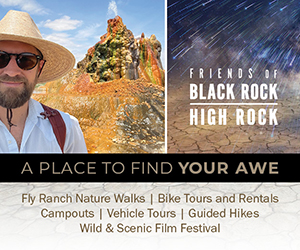Road Trip To A Future Past
Spring/Summer 2025
How the 1987 film “Cherry 2000” turned Nevada’s landscapes into an alternate future universe worth exploring.

BY MARK MAYNARD
Steve De Jarnatt has a shock of white hair like what might sprout from the head of a mad scientist. He has more than four decades in the entertainment industry and seems to have done it all, from directing a Las Vegas-set episode of “Alfred Hitchcock Presents” in 1985 to publishing a short story collection in 2020 titled “Grace for Grace.” But De Jarnatt is best known for writing and directing his revered cult film: 1988’s “Miracle Mile”, which still makes top 10 lists to this day—most recently coming in at No. 1 on Screen Rant’s “10 End Of The World Movies That Actually Ended With The End Of The World.”
In 1987, a year before shooting his magnum opus, De Jarnatt helmed his first feature film, “Cherry 2000”—a strange, post-apocalyptic piece that melded the ‘80s surfer vibe of Southern California with a “Road Warrior”-esque female tracker. This fusion was wrapped in a campy sensibility that played out across the deserts, towns, and industrial ruins of rural Nevada.
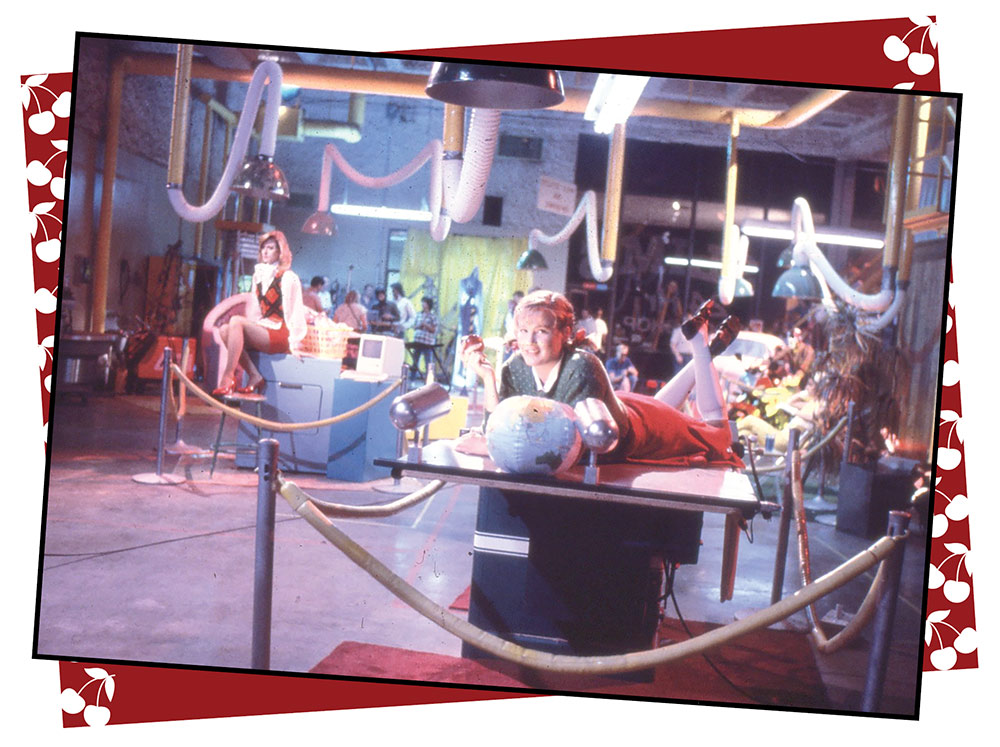
WELCOME TO ZONE 7
For “Cherry 2000,” De Jarnatt received a budget of $10 million, which—with the help of a talented, young crew—he used to build a futuristic, dystopian vision of Santa Monica, California in the Silver State.
The film evokes an alternate reality where an apocalypse has decimated manufacturing and everything must be made from recycled parts. In the movie, Sam Treadwell—played by David Andrews—is married to a robot woman named Cherry, played by the late Pamela Gidley. After Cherry breaks down in a soap-sud incident, Sam must travel from their home in Southern California to find her a replacement body in the lawless Zone 7.
To navigate this dangerous wasteland, Sam employs E. Johnson, a fire-haired tracker and force of nature played by future Oscar-nominee Melanie Griffith. E. Johnson brings knowledge, moxie, and an off-road-capable red Ford Mustang loaded with horsepower and guns.
Nevada makes an engaging Zone 7, and the film was shot almost entirely on location at many historic and natural landmarks in Nye, Esmeralda, and Clark counties. If you’re ready to take the trip, fire up your Mustang, make sure your tires are solid, and get ready to drive where the rule of law ends in Zone 7. Note: If you have not yet seen “Cherry 2000,” there are many spoilers ahead.
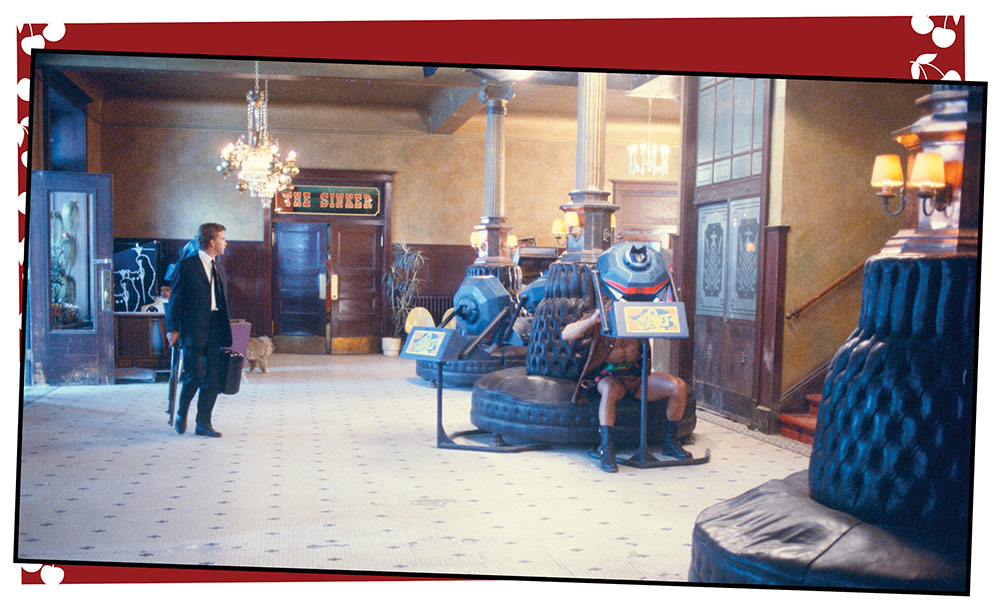
TONOPAH AND GOLDFIELD
Although little of Tonopah appears in “Cherry 2000,” the town served as headquarters for the cast and crew while shooting in Goldfield, Rhyolite, and Beatty.
The film got a young Tonopah resident in the final credits: Bambi McCracken, a Tonopah High School student and daughter of Nevada historian and writer Robert D. McCracken. Bambi was cast as Melanie Griffith’s stand-in and even had a non-speaking role as the Bambi 14 model in Slim’s Body Shop.
De Jarnatt recalls one night when they closed Goldfield’s main street for a driving scene. The production manager had sent Griffith’s stunt double home, so someone suggested they have McCracken do the driving.
“They said, ‘Let’s just have Bambi pull up in the car and stop on a dime,’” remembers De Jarnatt. “And then it just started snowing. The road was freezing, and I said ‘I’m not killing high-school-girl Bambi McCracken.’”
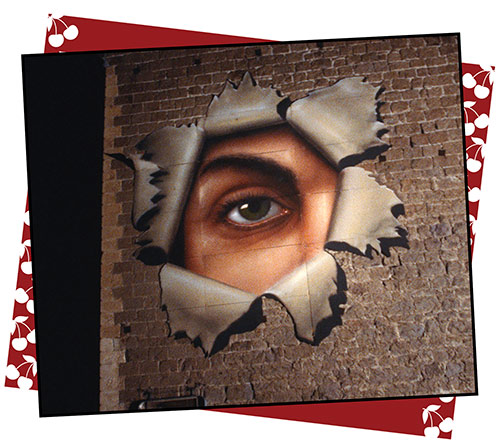
Indeed, the historic mining town of Goldfield plays a significant role in “Cherry 2000” as the futuristic Wild West town of Glory Hole. The Goldfield Hotel became the Glory Hole Hotel— its historic bar now a donut shop and saloon called The Sinker. Nearby, the brick wall of the John S. Cook Bank building was embellished with a huge mural that can be seen in several scenes.
Alan Metscher is a third-generation Goldfielder—his grandfather settled there in 1903. He is president of the Central Nevada Historical Society and a co-founder of the Central Nevada Museum. Metscher remembers when the film crew arrived in 1987.
“I was living in Tonopah at the time,” says Metscher. “I made a few trips over here just to watch what was taking place during the street scenes.”
Asked if he remembered the film’s red Ford Mustang, he laughs recalling a car-hauler packed with the car.
“They didn’t use the same Mustang over and over again: They had different ones.”
GHOST TOWNS
A lone road sign stands in the dark desert exhorting drivers to proceed with caution. The tracker E. Johnson fires up the advanced engine of her pony, and the pair speeds into the night, headlights off, driving—to quote the film— “by feel, mostly.”
They come to The Barricades: a roadblock and checkpoint manned by dozens of armed figures. Set outside Rhyolite’s famous 1907 Cook Bank building—that’s right, this film features both of central Nevada’s Cook bank branches—The Barricades bristle with spotlights, anti-tank traps, and barbed wire. Sam and E. Johnson must speed through this gauntlet, dodging flame-throwers, machine guns, and explosions.
The film didn’t just use Rhyolite’s main street. The Rhyolite Train Depot served as E. Johnson’s house and office. Through skillful edits, the swinging sign on her porch “E. JOHNSON | TRACKER | …NEVER SAYS NO” is visible through Sam’s window in the Glory Hole Hotel, 72 miles away.
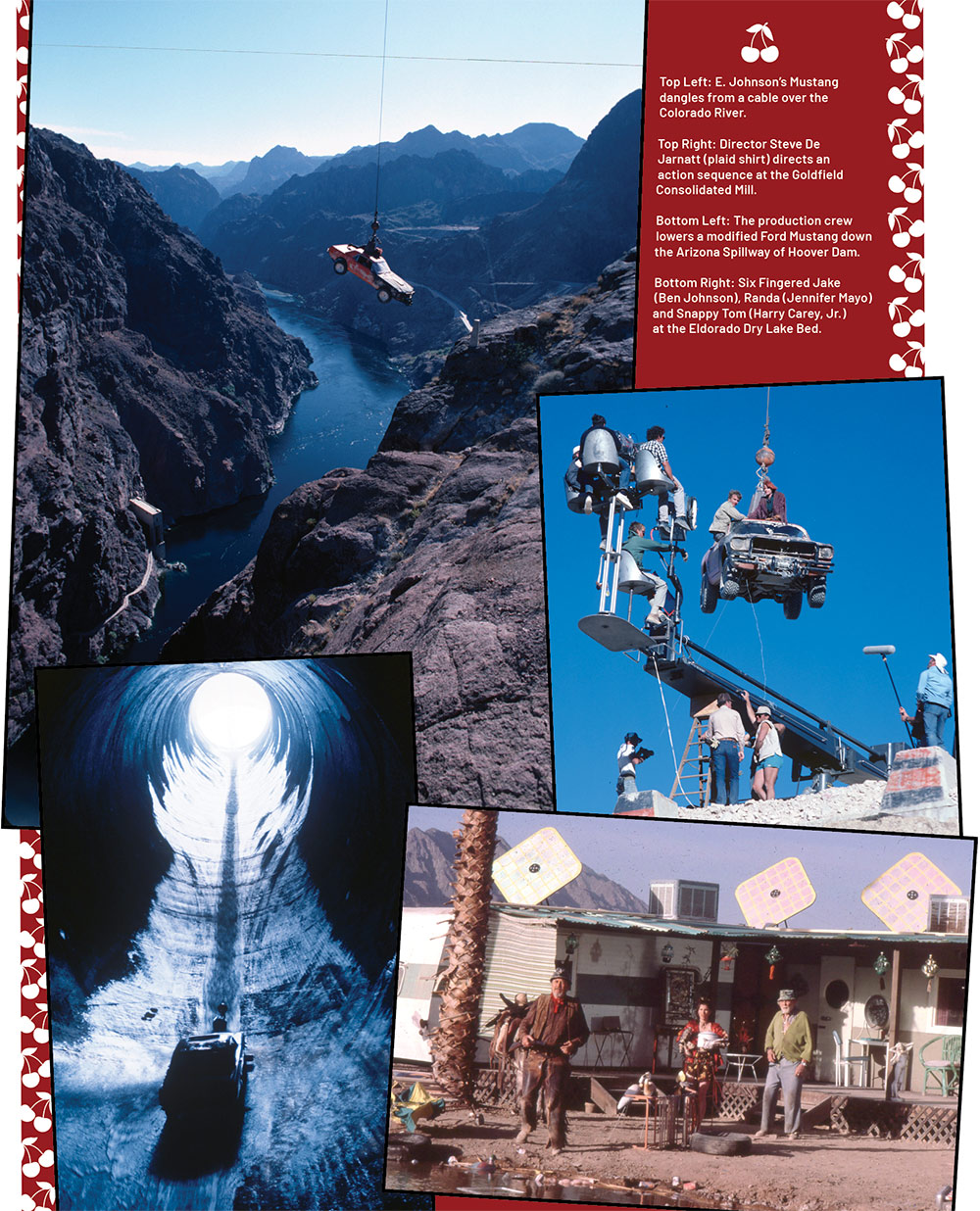
MINE PITS AND DAMS
After E. Johnson and Sam survive The Barricades, they find themselves at the edge of a large open pit mine. Looking across with binoculars, they see the film’s villain Lester: judge, jury and executioner of Zone 7. They watch as Lester loads a victim into a panel truck and sends them over the edge to smash onto a ledge partway down the pit.
The sequence was shot at the Three Kids Mine, a World War I-era manganese mine located near Lake Mead off Highway 564. De Jarnatt says the truck was supposed to fly out farther from the rim and land in a lake at the bottom.
“I would have preferred the long splash,” he says.
Next, a scene filmed at the ruins of the Goldfield Consolidated Mill opens one of “Cherry 2000’s” key action sequences. Sam and E. Johnson approach the mill, expecting an aerial ride across a large river. Suddenly, an electromagnet snags their Mustang and hoists it into the air with a crane. It’s an ambush!
Lester’s gang shows up, peppering them with rocket-propelled grenades. A gun-and-grenade fight breaks out to a swelling classical score as mining shacks and tailings are blasted in a series of explosions. At the climax of the scene, the crane swings around and dangles the protagonists perilously over the Colorado River near the Hoover Dam—a location 220 miles away. This was perhaps the most inspired of the stunt sequences in “Cherry 2000.”
“The studio wanted a big stunt they could use for the poster,” says De Jarnatt.
The director, crew, and stunt performers delivered—all without CGI or camera tricks. As E. Johnson cuts the swinging car free from the electromagnet to leave it dangling from a separate cable, the car drops from horizontal to vertical, whiplashing the stunt performers.
“The stunt that Tracy Keene did? That’s a real person over the Colorado River, on the back of a Mustang, swinging way above everything. I mean, it’s insane,” De Jarnatt remembers.
Next, with permission from the National Park Service, the crew was able to include a second part to the stunt. They lowered the Mustang and two stunt performers into the upper end of the Arizona Spillway at Hoover Dam. Then, they dropped the car, still tethered, down the 600-foot concrete chamber for a once-in-a-lifetime shot.
“First of all, the fact that they would just let us have the run of Hoover Dam,” says De Jarnatt laughing. “I don’t think that happens today. ‘Oh, can we shoot inside this spillway?’ ‘Yeah, why not?’”
DRY LAKES AND DUNES
Veteran character actor Harry Carey Jr. had a storied career that included such films as 1956’s “The Searchers” with John Wayne, 1984’s “Gremlins,” and 1998’s “Tombstone.” In “Cherry 2000,” we find his character Snappy Tom at his compound called Last Chance Brothel and Gas. The location is the Eldorado Dry Lake Bed—an area now popular for off-highway vehicles, land sailors, and even falconers—located southwest of Boulder City.
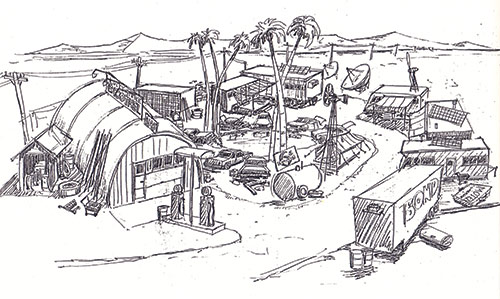
“We built a set that looked like the first Burning Man,” says De Jarnatt. “Snappy Tom’s mud flat.”
It’s not hard to see the comparison with the annual event held hundreds of miles north. The set consisted of a compound of trailers, junked cars, shopping carts (a motif in De Jarnatt’s films), colorful decorations, and upcycled art.
Last Chance Brothel and Gas is the site of a standoff between the film’s main cast and is where E. Johnson fixes up an old airplane that will take her and Sam (and Cherry) to the climax in sand-buried Las Vegas.
“You know, we were the first film to put Vegas under sand dunes,” says De Jarnatt, comparing his desert wasteland of Vegas Village to the post-apocalyptic ruins depicted in Denis Villeneuve’s “Blade Runner 2049.” Interestingly, the latter was filmed in 2017,
the year “Cherry 2000” is set in.
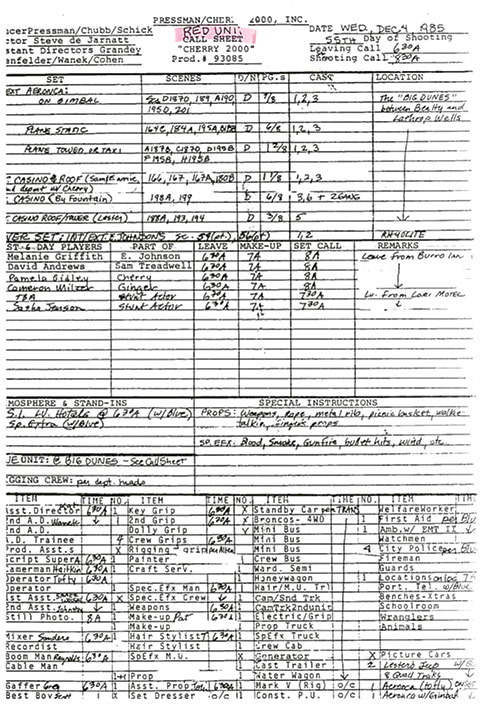
The film’s finale (think human-robot love triangles, a gunfight, aerial stunts, and sandwiches on the sand-encrusted Strip) was actually filmed just south of Rhyolite at the Amargosa Big Dune, located between Beatty and Pahrump on U.S. 95.
To bury Las Vegas, De Jarnatt and his crew built large practical sets at the dune and then used glass plates to give an in-camera effect of a ruined Vegas Strip. In the film, a dune-buried Pharoah’s Casino stands beside a pavilion topped with showgirl statues. Nearby, sits the lamp that once belonged to the sign for The Aladdin Hotel and Casino, now held in the Neon Museum’s permanent collection.
CITIES AND PARKS
Many other locations across southern Nevada get a cameo appearance. Later in the film, the protagonists meet Six Fingered Jake, who lives with a pack of burros in a cave where he hoards stacks of toaster ovens—hard currency in a post-apocalyptic world. Jake’s hideaway is really Techatticup Mine in Eldorado Canyon, located near the small town of Nelson. This area still offers mine tours and is popular for weddings, picnics, and photography.
A subsequent scene has E. Johnson, Sam, and Six Fingered Jake motoring on a barge with a hull made from a Marlboro cigarette billboard. This was filmed in the green-water of Emerald Cave, now a popular kayaking destination near Hoover Dam.
Nearby at Valley of Fire State Park, the sandstone formations known as The Beehives served as backdrop for Sky Ranch—Lester’s compound. Because it was a state park, the crew had to be careful not to disturb any of the natural habitat and built the set on structures designed for fragile tidal areas.
Several Las Vegas venues were used for indoor and exterior sets including Sam’s dreary office complex, suburban house, and Slim’s Body Shop. In Las Vegas, they also filmed the neon-infused Glu-Glu Club, where you need a lawyer to negotiate a date with a human companion—look for a young Lawrence Fishburne.

WORTH A WATCH
“Cherry 2000” is fun, strange, and worth watching—especially for fans of Nevada landscapes and late-80s action movies. Best of all, a special edition was just released in December 2024 on Blu-Ray. This version includes an excellent feature-length documentary on
the making of the film called “Tales from Zone 7.”

